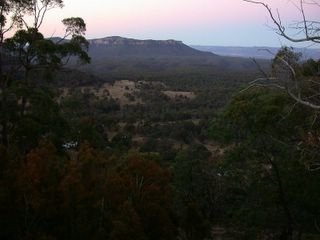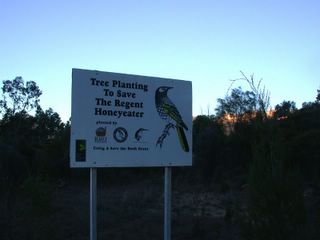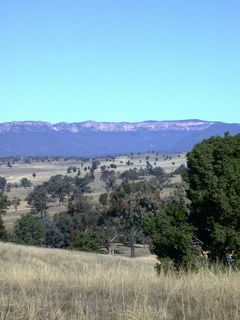Capertee Valley - 23 Jul 2005
Thursday, July 28, 2005
In Search for Regent Honeyeater
Capertee Valley is 232km away from Sydney. The journey is approximately 3.5 hours' drive one way. This place is one of the few remaining places where the endangered Regent Honeyeater breeds. Even so, Regent Honeyeater does not seem to occur in good number every year. This year is one of the best seasons ever reported in recent time.
To see information and photos on my previous trip to Capertee Valley, follow link http://caperteevalley20050710.blogspot.com/
 Capertee Valley (View from Pearson Lookout, taken at late afternoon just before I left for home)
Capertee Valley (View from Pearson Lookout, taken at late afternoon just before I left for home)
I left home 23 July 2005 at sunrise. As I drove towards the inlands of Sydney, I started to see morning frost in many places between Penrith and Lithgow. It must have been very cold the night before in some areas in Blue Mountains and western Sydney. It was a sight to see a wash of white over the landscapes, but this may not look good to farmers and the frozen slippery paved road is also dangerous to driver.
To see information and photos on my previous trip to Capertee Valley, follow link http://caperteevalley20050710.blogspot.com/
 Capertee Valley (View from Pearson Lookout, taken at late afternoon just before I left for home)
Capertee Valley (View from Pearson Lookout, taken at late afternoon just before I left for home)I left home 23 July 2005 at sunrise. As I drove towards the inlands of Sydney, I started to see morning frost in many places between Penrith and Lithgow. It must have been very cold the night before in some areas in Blue Mountains and western Sydney. It was a sight to see a wash of white over the landscapes, but this may not look good to farmers and the frozen slippery paved road is also dangerous to driver.
Some Points to Note in Capertee Valley
Capertee Valley is fringed by Wollomi National Park and Gardens of Stone National Park. However, most of the good birding areas are within farmlands and private properties, hence no trespassing please. All my photos were taken along road side and there was no need to climb over the fence to get closer to the birds, so far so good :)
 Red-roofed Cottage in idyllic setting
Red-roofed Cottage in idyllic setting
Farm-stay accommodations are available to visitors in quite a number of properties. Some good bird sightings are actually reported from these properties but they are not accessible to uninvited intruders.
Most part of the roads in Capertee Valley is still unpaved and there is no mobile phone coverage, at least not for my Vodafone. A public telephone booth is situated in Glen Alice. There are no shops and no public facilities such as toilets except in Capertee town.
 Red-roofed Cottage in idyllic setting
Red-roofed Cottage in idyllic settingFarm-stay accommodations are available to visitors in quite a number of properties. Some good bird sightings are actually reported from these properties but they are not accessible to uninvited intruders.
Most part of the roads in Capertee Valley is still unpaved and there is no mobile phone coverage, at least not for my Vodafone. A public telephone booth is situated in Glen Alice. There are no shops and no public facilities such as toilets except in Capertee town.
Big Eagle Day
It is not bad to start off my bird list of the day with this stunning juvenile Wedge-tailed Eagle that shows pale rufous nape and shoulder. The adult should look much darker.


 'Frozen' Wedge-tailed Eagle in frosty morning
'Frozen' Wedge-tailed Eagle in frosty morningThe reason that I had luck with this huge perching eagle was probably due to very cold frosty night the night before. The bird looked a bit clumsy in the cold morning. As the day got a bit heated up as well as getting annoyed by my red car, it flew off and glided in the sky to start off its daily hunt with the help of thermal. Wedged-tailed Eagle is reasonably easy to see in Capertee Valley, but to see it perching in close range requires some luck and patience as this is quite a shy bird despite being the largest raptor in Australia. (Male 90cm, Female 1m)
The Star Bird
The main purpose of this trip is to look out for Regent Honeyeater. As I am now familiar with the call, it did not take me long to locate the bird soon after arrival at the site.
 Regent Honeyeater (Xanthomyza phrygia)
Regent Honeyeater (Xanthomyza phrygia)
However I failed to find any at another spot which was recommended by 2 birders whom I bumped into. They saw more Regent Honeyeaters, hawking for insects.
Besides Regent Honeyeater, there are many other interesting birds that can also be found in Capertee Valley, such as Swift Parrot, Turquoise Parrot, Painted Honeyeater, etc.
 Regent Honeyeater (Xanthomyza phrygia)
Regent Honeyeater (Xanthomyza phrygia)However I failed to find any at another spot which was recommended by 2 birders whom I bumped into. They saw more Regent Honeyeaters, hawking for insects.
Besides Regent Honeyeater, there are many other interesting birds that can also be found in Capertee Valley, such as Swift Parrot, Turquoise Parrot, Painted Honeyeater, etc.
Monday, July 25, 2005
 Calling for a mate. It is mating season!
Calling for a mate. It is mating season!This Regent Honeyeater shown above is calling actively in the morning, probably to attract a mate nearby. It is currently breeding season for Regent Honeyeater as well as many other birds in Capertee Valley. Nearby, a White-plumed Honeyeater is seen busy building up its nest hidden under thick foliage of a short tree.
 Brown Treecreeper
Brown TreecreeperSharing habitat with the Regent Honeyeater is this Brown Treecreeper. Treecreeper is very active bird that feeds vertically up and down on tree trunk.
Some of birds sighted during this trip:
Australian Wood Duck
Wedge-tailed Eagle (Perched, see photo)
Little Eagle (Feasting on road-killed rabbit at road side, see photo)
Australian Hobby (Perched, see photo)
Little Pied Cormorant (Glenowlan creek)
Peaceful Dove
Little Lorikeet
Red-rumped Parrot
Eastern Rosella
Galah
Sulphur-crested Cockatoo
White-browed Babbler
Brown Tree Creeper (see photo)
Noisy Friarbird
Red Wattlebird
Regent Honeyeater (At least 4 birds at one spot, one with orange leg band)
White-plumed Honeyeater
White-naped Honeyeater
Noisy Miner
Grey Shrike-thrush
Grey Butcherbird
White-bellied Cuckoo-shrike (Both normal and dark phase seen at same spot, dark phase has barred belly)
Flame Robin (lovely male perched low on the farmland fence)
Southern Whiteface
Yellow-rumped Thornbill
Jacky Winter
The Fight Over Nectar
The White Box is in full bloom at the moment and it has attracted a lot of nectar eating birds. The most common and the most dominant of all is the Noisy Friarbird. It will chase away any birds including its own species that try to have a share of the nectar.
 Noisy Friarbird Tree - Glenowlan Road
Noisy Friarbird Tree - Glenowlan Road
This is one of many trees that is ‘infested’ by Noisy Friarbird. The dot at left of the trees is the bellicose Noisy Friarbird hovering around.
 Noisy Friarbird Tree - Glenowlan Road
Noisy Friarbird Tree - Glenowlan Road This is one of many trees that is ‘infested’ by Noisy Friarbird. The dot at left of the trees is the bellicose Noisy Friarbird hovering around.

This is the true culprit - the Noisy Friarbird. There were so many of them but I did not bother to take a good photo of them. Sometimes I wonder if we could judge the character of the bird (or a person) by its look. This looks like a villain - and it is indeed.

This is a male Red-rumped Parrot whereas the female is alot duller. It also joins the feast of the nectar rich tree with the Noisy Friarbird. There was actually another female on the same branch. They fluffed up their feathers and shook their body simultaneously, probably doing some courtship display.
Raptor Surprises
 Australian Hobby
Australian Hobby
Seeing Raptor on perch is always an exciting moment. Here is an Australian Hobby. Its mate was flying around nearby.
 Australian Hobby
Australian HobbySeeing Raptor on perch is always an exciting moment. Here is an Australian Hobby. Its mate was flying around nearby.
 Can you see a bird is standing at road side?
Can you see a bird is standing at road side?The most unexpected encounter of all is a Little Eagle feasting on a road-killed rabbit at road side. I could not believe my eyes as I drove pass a big bird standing still. I pulled up after passing 10 meters, looked back it was still there. I only managed to get an insurance shot. It flew away as soon as I got out from my car.
Some Publicity
 Signboard just before the turn to Crown Station Road
Signboard just before the turn to Crown Station Road
Signboards have been put up in Capertee Valley to showcase some conservation efforts currently underway to create more suitable habitat for Regent Honeyeater. The relatively shorter trees behind the signboard suggest that the trees were planted not many years ago. Looks like conservation project especially like this one are more like a long term commitment.
IT DOESN’T TAKE LONG TO CHOP DOWN A PATCH OF FOREST BUT IT TAKES SO MANY YEARS TO BRING BACK THE LOST HABITAT.
One benefit of putting up signboards will at least create awareness to the public of the importance of this tree planting project. Using Regent Honeyeater as a flagship icon is definitely more effective than not using any eye catching animal at all, as not many people besides seasoned birdwatchers have a chance to see this beautiful bird.
For more information on how to help protect the endangered Regent Honeyeater, visit http://www.absa.asn.au/regent/regentactions.html
Other link
http://www.birdlife.net/datazone/species/index.html?action=SpcHTMDetails.asp&sid=5374&m=0
 Signboard just before the turn to Crown Station Road
Signboard just before the turn to Crown Station RoadSignboards have been put up in Capertee Valley to showcase some conservation efforts currently underway to create more suitable habitat for Regent Honeyeater. The relatively shorter trees behind the signboard suggest that the trees were planted not many years ago. Looks like conservation project especially like this one are more like a long term commitment.
IT DOESN’T TAKE LONG TO CHOP DOWN A PATCH OF FOREST BUT IT TAKES SO MANY YEARS TO BRING BACK THE LOST HABITAT.
One benefit of putting up signboards will at least create awareness to the public of the importance of this tree planting project. Using Regent Honeyeater as a flagship icon is definitely more effective than not using any eye catching animal at all, as not many people besides seasoned birdwatchers have a chance to see this beautiful bird.
For more information on how to help protect the endangered Regent Honeyeater, visit http://www.absa.asn.au/regent/regentactions.html
Other link
http://www.birdlife.net/datazone/species/index.html?action=SpcHTMDetails.asp&sid=5374&m=0
Wrap Up for the Day

I hope Regent Honeyeaters manage to thrive on these remaining small pieces of suitable habitat and look forward to see more successful breeding in next trip.
Any comments, feel free to write to copsychus at yahoo dot com
To see information and photos on my previous trip to Capertee Valley, follow link http://caperteevalley20050710.blogspot.com/
Help Save Regent Honeyeater!

I hope Regent Honeyeaters manage to thrive on these remaining small pieces of suitable habitat and look forward to see more successful breeding in next trip.
Any comments, feel free to write to copsychus at yahoo dot com
To see information and photos on my previous trip to Capertee Valley, follow link http://caperteevalley20050710.blogspot.com/
Help Save Regent Honeyeater!



